Long-suffering-standing Cipher Mysteries readers cursed with photographic memories may recall a post I made back in 2008 that included images of Giovanni da Fontana’s rather wonderful Bellicorum Instrumentorum Liber. Because this is a book-sized enciphered manuscript, it is a member of a highly select club, with little more than the Voynich Manuscript and Rohonc Codex to keep it company at their Christmas dinner.
As Bert Hall put it rather nicely, though, the Bellicorum Instrumentorum Liber is not so much an illustrated text as a series of drawings accompanied by a bit of text (partially enciphered text, in this case). And the whole book is available online, which is just splendid.
Bellicorum Instrumentorum Liber
One of my favourite images from the Bellicorum Instrumentorum Liber is of what seems to be a skateboarding rabbit. By which I mean not something from Pinterest…
…but something from Bayerische Staatsbibliothek München Cod.icon. 242, fol. 37r, urn:nbn:de:bvb:12-bsb00013084-8 (“Mechanische Maschinen und Automaten”), dating to between 1420 and 1430…
If we look at the same image in context, it becomes immediately clear that this isn’t an anachronistic exercise in Internet whimsy, but a state-of-the-art early Renaissance killing machine:
This ‘rocket rabbit’, then was a quasi-terrorist device, to propel itself at speed at the foot of a building and blow itself up.
Oh, And The Rocket Cat As Well
Fontana’s rocket rabbit seems to have inspired this 1584 “rocket cat” (and similar “rocket bird”), which I saw discussed at a UPenn blog back in 2013:
The blog post also pointed to a c.1530 rocket cat:
Now Build Your Own…?
But it seems – to my eyes, at least – that even though written descriptions of “fire birds” setting besieged towns [alight] predate the Renaissance by half a millennium, it was Giovanni da Fontana’s rocket rabbit that begat the rocket cat. And what is particularly nice is that he shows us how to build one, piece by piece on Bayerische Staatsbibliothek München Cod.icon. 242, fol. 16v, urn:nbn:de:bvb:12-bsb00013084-8 (“Hydraulische Maschinen und Automaten”):
All of which, I believed, marked the end of this whole interesting line. For who on earth would be so splendidly insane as to actually build one of these for themselves? Such a person would need to have great expertise in making 3d models and historical reconstructions, and they’d need a film production company to fund it, etc etc.
That was never going to happen, was it?
Richard Windley
Step forward Richard Windley, who (it says here) “has lectured part-time in 3D Design at Hereford College of Art as well as making models and reconstructions for film and television productions”.
And step forward his awesomely wonderful rocket roller car, that was called “Fleeing tortoise” (as per the Latin description on the page) and was built for an Ancient Discoveries episode that aired on the History Channel (3×09 “Ancient Robots”? Perhaps there’s a copy on YouTube somewhere, but I haven’t yet found it):
Those who remember Zeno’s paradoxes of motion may recall that a fleeing tortoise was proved to be swifter than Achilles (to a Greek logician, anyway):
Here was Richard’s preliminary rocket car test run (in his back garden):
His car indeed went like the rocket that it was, too bright and almost too fast to capture on a normal camera:
Zeno or no Zeno, I’d like to see Achilles try to outrun that fleeing tortoise. 🙂
But my favourite photograph of the many that Richard kindly shared with me is of him in his protective “furnace suit” (though this was for a separate – and potentially lethal – Greek Fire demo for a different documentary):
If there’s a more evocative photo of an historical maker out there, I’ve yet to see it! 🙂

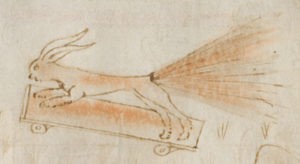
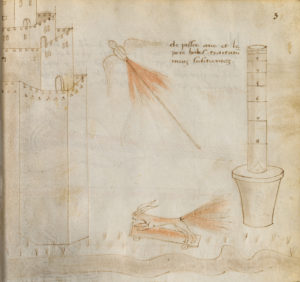

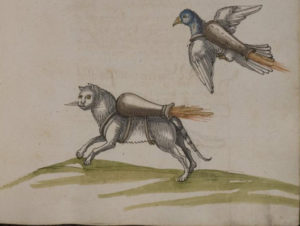
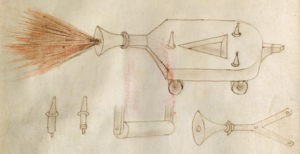

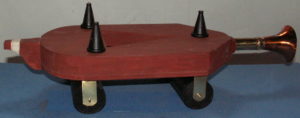


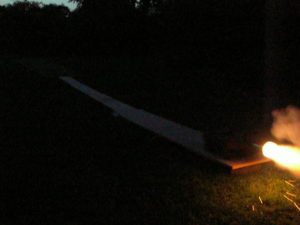

And in this way, with interesting specialist blog, Nick, you did populist – circus shit. But this is not a surprise.
What would we think of rabbits and cats who put fireworks in the human fundament to assist some irrational desire to eliminate as many as possible of their own species?
I agree with whoever it was who said that I don’t mind people but human beings en masse are pretty ghastly.
Gregory: some circuses are really cool. But I draw the line at exploding animals – not cool.
But Nick, where is there any picture of an exploding animal? Fart propelled rabbits (or, at least, fart-propelled rabbit turds could be more likely weapons). I raised angora rabbits (and plucked their fur for knitting mittens.) I also knitted a ‘bat-winged sweater (which is now stored (with moth balls) in a trunk (NOT an elephant’s trunk).
Song:
I went to the animal’s fair .
The birds and the beasts were there .
The big baboon,
by the light of the moon,
was combing his auburn hair.
The elephant sneezed
and fell to its knees
and what became of the monk, the monk, the monk?
😉
How do we prove the Voynich is not lost books of Fontana.
xplor: it’s a good question. However, Giovanni da Fontana helpfully provided lists of the books that he’d written, and I think they have all been accounted for by historians.
However, the thorny issue is that we don’t know when or where he died (1454 or later, as I recall), so it remains possible that the Voynich Manuscript was a late or very secret piece of writing by him. But that’s basically as much as we can say for now.
You think a magus would have secrets ? After he was accused of witchcraft he went to Udine as the doctor. Married and had a son.
The guy Clagett died too soon or we could ask him.
Nick,
To argue that the imagery in the Voynich manuscript is Fontana’s work, you’d have to posit that he’d thrown way his ruler, his interest in perspective drawing (though one of the copyists for Beinecke 408 couldn’t resist showing off, I admit), and his interest in angels, devils and naturalistic looking animals. Plus – as the example in f.25v shows – he could have had to develop suddenly a desire to draw one dragon as they’d been drawn centuries before.
Which is not to say the text might not turn out to be about exploding banana-plants. 🙂
It’s the usual acid test: would any reputable appraiser agree to offer the manuscript for sale in terms of a given Voynich theory? imo – anyone trying to offer it as by Fontana, or even “of the school..” would be drummed out of the job. Sorry.
Diane: the Voynich Manuscript’s hand(s) are indeed not at all like Fontana’s – but then again, I think there are plenty of sound reasons to think that it was copied / written down by a mid-fifteenth century scribe-for-hire, so all bets are still off as to whose manuscript it ultimately is.
As to ‘of the school of’ arguments, I’d say that the Voynich Manuscript is clearly not of any school or tradition we know of, Fontana’s or otherwise. So your putative appraiser would still be scratching his or her head, whomsoever one might notionally attribute the manuscript to. 😐
Nick,
I absolutely agree that the current text is the product of mid-fifteenth century copyists (I’d say more than one, and there think I also agree with your views?).
About the appraisers – no, I can’t agree there. Before the cryptanalysts got involved and all sense of balance was lost in how the manuscript was treated – I mean it came to be seen as consisting of a ‘cipher text’ without much attention paid to the manuscript qua manuscript – there were a number of competent and experienced appraisers whose opinions are not irrenconcilable if one accepts that the present manuscript was made as a near-facsimile from exemplars dating to the mid-to-late thirteenth century.
The consensus of the most experienced and the most acute were that the work presented as a southern (Sephardi/Mizrahi) Jewish work (Panofsky) and that it looked like an English work of the same mid-to-late thirteenth century (or so). Because of certain pigments’ addition, and because the ‘new world theory’ saw a sunflower where none exists, that original view was adjusted to allow for the “1492” events. I don’t believe that adjustment was necessary, though certainly, at the time, the diplomatic option.
So the appraisers weren’t all that phased, even if put off their stroke a little by the plainly non-Latin-European character of the imagery and the unreadable script. Modern appraisers, I’m sure, would not fall into a heap, either. I reckon someone from UPenn – especially the Schoenberg Library – could write a pretty fair comparative essay, and I’d also be interested in what the appraisers from Enluminures might have to say.
Shall we bet a duck on it? Perhaps Peking duck would travel better, if we have to post the prize. 🙂
Diane: I strongly suspect that our two frames of reference do not yet overlap enough to make a bet epistemologically meaningful/possible. But I look forward to the day when they do, and will try to have my own Peking duck ready. 🙂
Since some of Fontana’s work is known it might be a good idea to look into how his secret writting evolved.
The voynich has no corrections. That might be deliberate as only someone that knew the code would see the misscopied letters and it would stop others from
solveing it. 3onthis post
Nick, why does any new topic you post lapse into discussions/references to the worn-out B-408 mss? Do you have a polite way of shifting discussions back to the subject you have just posted?
Can you tell us more about da Fontana and richard windley? I’m not yet resigned to following endless arguments and references to other contributors on your various posts.
BTW: Were you able to visit the Hakluyt Society meeting. I was hoping that someone would tell us how Senor/Professor Armesto contributed to their event. He is a remarkable writer/teacher.
bd
Nick –
The bet is that if, were we to enlist the sort of appraisers who are experts at appraising manuscripts, and had no vested interest in a V-theory (non-rocket), then they wouldn’t be so fazed as to be unable to give an informed and coherent opinion.
bdidr. If you read Nick’s book, and between the lines and/or the pics… the lines all point to that worn-out manuscript and various current currents. 😀
As I recently contacted Nick: “I’ll purchase his first book when he can offer his next book — full price for each, but packaged together.
Doing the best I can to stay on a subject I posted to Nick (not too long ago): Nick, were you able to attend (or view the activities/latest meeting of the Hakluyt Society)? I’m inquiring because Professor Felipe Fernandez-Armesto (Professor of History at Notre Dame University) was a guest speaker at their latest meeting (rendezvous) ? His book “Millenium: A History of the Last Thousand Years” became the subject of a ten-part series on CNN). I don’t have a TV — so I’m hoping Netflix will be catching up with Professor Armesto — sometime B4 I die!
PS: Nick, Diane, Sir Hubert, I have rarely ever gotten an encouraging review of my translations of some 30 folios in the “Voynich” manuscript. The translations are not just about botanical matters, but also the care and nourishment of young, soon-to-be mothers. The ‘so-called Voynich” manuscript was Fray Sahagun’s personal diary (which details his voyage to the New World and his setting up a school to teach young men how to write their own history in their own language. He also went completely around the lake interviewing some of their elders.
And, Diane, I have not yet gotten an answer to my attempt to get a copy of his first book (about a year or so ago). So, its kind of hard to read his publications (Even though I do have “Adobe Acrobat” reader – which enables me to read the entire contents of Fray Sahagun’s so-called “Florentine Codex”.
I have, however, gotten some very polite responses from gentlemen who have been following the mysterious death of Ricky McCormick (on Nick’s two discussions in re McCormick’s notes of what he observed going on at what was actually one large dumpsite which encircled the other.
Correction to “Animal Fair” : ‘You ought to’ve seen the monk — he jumped on the elephant’s trunk……
bd
Nick has been looking at Giovanni Fontana of Venice for over 14 years. Lynn Thorndike calls him John Fontana and in german they call him Johannes. A common name that wrote a lot of books, some in code.
In one of his letters to Domenico Bragadino he mentions his book on mensuration.
Sidenote: BD did you show your rabbits ?
Hi, xplor ! Because they were full-size pure white long-haired angora rabbits, they would not have survived various fairs or shows — very hot, and not much shade. My white geese, however, won first prize ribbons. I’m sure you’ve seen, here and there, the expression ‘silly goose’. Well, along with the white hatchlings, came a Canada Goose. Here, on Nick’s site, I’ll try to be brief : there is no such thing as a dumb Canada Goose. Hey, Goose, are you following this recent commentary?
Nick, I apologize in advance, 1-nce again, if I’ve led the commentary astray!
bd id 1dr
“Bandit”, my Canada Goose, would follow us (my husband and me) when we were ‘potting on’ from our compost pile. A scoop of compost into a clay pot would be followed by a bill-full from “Bandit”. Bandit also would stand guard, at night, over our chickens (Araucanas), geese, and rabbits. What was interesting to me was that our white geese were very noisy — but never a sound from Bandit.
Several days after the sale of our white geese, we found Bandit dead, with her throat torn out.
bdid1dr: it sounds as though your white geese were protecting your Canada Goose rather than vice versa.
Diane, I got into serious trouble with Nick, several months ago, in re ‘ducking issues and ‘quack quack’. Nick and I worked out the issues and I apologized for creating a “tempest in a teapot”.
So, Nick, I hope I’m staying within your borders of what is relevant to your ‘blog-of-the-day”.
beady-eyed-1-der
🙂
Nick, once the white geese were no longer ‘home’, Bandit was able to get ‘some sleep-eye/naps. So, we still were not able to determine if it was a cat or a raccoon, or even an owl, which climbed or flew over the eight-foot high ‘chicken-wire’ fence, to tear out her throat.
Back to rocket-propelled rabbits/cats/birds: Mr. Windley’s beautiful tiny rabbit is, if I recall correctly, is what is called a dwarf, or Dutch miniature. Some rabbit breeders say “the smaller the breed, the meaner” or “crabbier”.
Oh yes, a reference to that ‘rocket propelled bird: could the drawing simply be indicating the use of pigeons (carrier pigeons) for carrying messages (even ‘way back when”) ?
bd
Do I recall correctly that Greenwich University had caged birds (pigeons?) and used them for carrying messages during WW II ? (The Blitz?)
bd
Imagine in the 1400s going down to the boat and buying chinese fireworks. The things on the rabbit, cat and bird are early bottle rockets. The Chinese idea stuck around and now power our space program.
Fumigators — whether it was a cat which could no longer chase and catch rats, just imagine the cat being harnessed to some kind herbal or arsenic to kill rats and insects in the various castles/compounds.
Rabbits harnessed also to a small tank of some foul-smelling liquid which would keep predatory animals away from the rabbit pens — so that rabbit owners could enjoy what may have been very tasty (rabbit-meat). And maybe even be able use the skins.
The birds speak for themselves (carrier pigeons and/or hawks which would predate upon just about ‘anything’ ). So, rather than flames — maybe just about anything I’ve just mentioned.
bd
N other of your posts, I’ve sung the song, sung in Hamlin town; which was full of rats……
bd
One of our secret weapons in world war II was incendiary bats . Old ideas never go away.
My kids grew up thinking chickens had four legs.
!!!!
bd
Incendiary bats !! I believe we have some of those in congress right now !!
Well, I’ve always wondered how bats got into belfries — and why.
I live in Greenviile, North Caroline in the United States
if you lived here and
if the local government found out you were studying this
they would lock you up
and force drugs on you
then rape you in a back room.
and break into your home and destroy your property
this is not a joke
this what they do to people who are not line with the way they want you to think. and these are the people who go to church on sunday